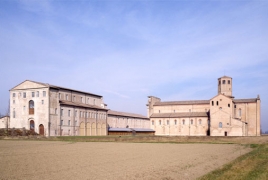
On Saturday May 23, at the Valserena Abbey, just a few kilometres from Parma, the Archive-Museum of the The Study Centre and Communication Archive (CSAC), opened to the public, Art Daily reports.
It brings together and conserves original materials of visual communication, artistic research and design in Italy starting from the first decades of the 20th century. An extraordinary legacy of over 12 million individual items: Fine Art (over 1,700 paintings, 300 sculptures, 17,000 drawings), Photography (with over 300 collections and more than 9 million images), Design (1,500,000 drawings, 800 maquettes, 2,000 objects and around 70,000 items from figurines, to drawings, sketches, clothes and magazines) and Visual Arts (100 original films, 4,000 video-tapes and numerous ancient movie projectors).
The CSAC, founded in 1968 by Arturo Carlo Quintavalle and subsequently managed by Gloria Bianchino, has been housed since 2007 in the Cistercian Abbey of Valserena, traditionally identified as Stendhal's “Charterhouse of Parma”. The abbey's interiors have recently been renovated through an important architectural project sponsored and backed by the University of Parma.
The CSAC is above all a new multifunctional space, a living machine featuring an Archive, a Museum and a Teaching and Research Centre, with the active participation of the scientific community and a circle of researchers, PhD students and undergraduates.
A formula unique in Italy, which maintains and boosts the activities of consultancy and support for university training carried out so far with seminars, workshops and apprenticeships, the organization of exhibitions and the publication of the respective catalogues (over 120 since 1969), and loans to exhibitions in other museums (among the international ones, the MoMA in New York, the Pompidou Centre in Paris, the Tokyo Design Centre, and the Museo Nacional Centro de Arte Reina Sofia in Madrid).
The new Archive-Museum's exhibits, filling the spaces of the grand Cistercian church, the Sala delle Colonne , Sala Ipogea and the Sculpture Court, represent all the complexity and richness of the archive's collection with over 600 works on display.
The sixteen sections of the display are dedicated to themes that bring out the complex nature of this Archive/Museum, by showing cross-sections of its collections: from Fine Art to Fashion, from Design to Photography, from Architecture to Advertising and even Satirical Drawings, with works and projects from, among others, Lucio Fontana, Giorgio Armani, Gianfranco Ferré, Achille e Pier Giacomo Castiglioni, Nizzoli and Bellini for Olivetti, Man Ray, Luigi Ghirri, Dorothea Lange, Giò Ponti, Pier Luigi Nervi, Giuseppe Samonà, Armando Testa, Tullio Pericoli, and Vincino.
Closing this choice is a monographic exhibition dedicated to the figurative and design culture of the ’60s and ’70s with works by artists that entered the CSAC collections right at the beginning, such as those by Enrico Baj, Mario Ceroli, Luciano Fabro, Emilio Isgrò, Enzo Mari, Giulio Paolini, Michelangelo Pistoletto, Mario Schifano, Ettore Sottsass, and Emilio Tadini.
The Sala delle Colonne is showing how works kept in the Fine Art Section Archive are collected and studied, with a chronological display of drawings by Mario Sironi of Visual Poetry, along with project and working documents. Visitors also are able to consult the archival materials kept in areas of the Abbey not open to the public, by pre-booking.
The Sala Ipogea, introduced by Il Sentimento della Rivoluzione by Fausto Melotti, supplements the sculpture display created in the Abbey's courtyard, which includes numerous large-scale sculptures.
The new CSAC boasts catering and accommodation services, including a restaurant-cafeteria and a hostel, set up in what were once the monks' cells.

